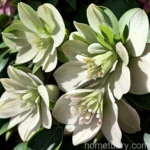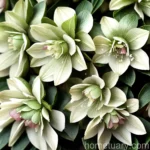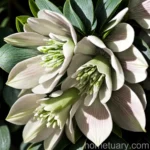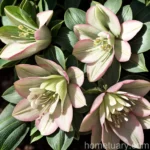All About Hellebore (Helleborus ‘Mardi Gras Double Mix’)
Helleborus, commonly referred to as hellebore, is a genus of perennial flowering plants in the family Ranunculaceae. Hellebores are native to Europe and Asia, and they are cherished for their delicate, nodding flowers that bloom during the winter and early spring. Among the various hellebore varieties, the ‘Mardi Gras Double Mix’ holds a special place with its stunning double flowers in a mix of captivating colors. In this comprehensive guide, we will delve into the captivating world of hellebores, focusing particularly on the ‘Mardi Gras Double Mix’, exploring its culture, uses, care requirements, and much more.
Key Takeaways – Helleborus ‘Mardi Gras Double Mix’
Before we embark on our journey into the enchanting realm of the ‘Mardi Gras Double Mix’ hellebore, let’s take a moment to highlight some key takeaways:
- Hellebore varieties offer a diverse range of flower types and colors, with the ‘Mardi Gras Double Mix’ standing out for its captivating double blooms in a vibrant mix of colors.
- Hellebores, including the ‘Mardi Gras Double Mix’, are shade-loving plants that thrive in cool, moist, well-drained soil.
- Culturally, hellebores have been used for medicinal and ornamental purposes for centuries, reflecting their versatility and significance in various traditions and practices.
- The ‘Mardi Gras Double Mix’ hellebore is a low-maintenance plant, making it an excellent choice for both experienced and novice gardeners seeking a touch of elegance in their outdoor spaces.
Now that we have a glimpse of what awaits us, let’s delve deeper into the captivating world of the ‘Mardi Gras Double Mix’ hellebore.
What is Hellebore (Helleborus ‘Mardi Gras Double Mix’)?
The ‘Mardi Gras Double Mix’ hellebore, a captivating cultivar of the Helleborus genus, is renowned for its exquisite double flowers that bring a burst of color and life to winter gardens. As with other hellebore varieties, the ‘Mardi Gras Double Mix’ thrives in partially shaded areas, making it a perfect addition to woodland gardens or shaded borders. Its flowers, emerging in late winter to early spring, display an array of hues, including shades of pink, purple, green, and cream, creating a mesmerizing spectacle that captures the essence of the changing seasons.
Culture
Uses
Hellebores, including the ‘Mardi Gras Double Mix’, serve multiple purposes in horticulture and traditional practices. Some common uses of hellebores include:
- Ornamental Purposes: Hellebores are widely cultivated for their aesthetic appeal, adorning gardens, landscapes, and indoor spaces with their enchanting blooms.
- Medicinal Applications: In traditional medicine, hellebores have been used for their purported therapeutic benefits, although it is important to note that parts of the plant are toxic and can cause severe discomfort if ingested.
Water
Proper watering is crucial for the health and vitality of the ‘Mardi Gras Double Mix’ hellebore. Here are some key pointers to keep in mind:
- Watering Frequency: Hellebores prefer consistent moisture, especially during their active growth periods. While they can tolerate dry conditions once established, regular watering is essential, particularly during dry spells or when grown in containers.
- Avoid Waterlogging: Ensure that the soil remains well-drained to prevent waterlogging, which can lead to root rot and other moisture-related issues.
Sunlight
Hellebores, including the ‘Mardi Gras Double Mix’, thrive in partially shaded to fully shaded areas. When selecting a site for planting or positioning containers, consider the following:
- Light Conditions: Choose locations with dappled shade or filtered sunlight, particularly in regions with intense summer heat.
- Soil Considerations: Opt for sites with fertile, well-drained soil to support healthy growth, and provide a cool, sheltered environment for optimal development.
Fertilizer
Proper nutrition is essential for fostering robust growth and abundant flowering in the ‘Mardi Gras Double Mix’ hellebore. Here are some guidelines for fertilizing hellebores:
- Fertilizer Type: Apply a balanced, slow-release fertilizer formulated for flowering perennials in early spring to support healthy growth and prolific blooms.
- Avoid Overfeeding: While hellebores benefit from periodic fertilization, excessive or late-season feeding can disrupt their natural cycle and lead to imbalanced growth.
Soil
The soil composition and quality play a significant role in the overall well-being of the ‘Mardi Gras Double Mix’ hellebore. Consider the following soil-related aspects:
- Well-Drained Soil: Hellebores thrive in humus-rich, well-drained soil. Incorporate organic matter such as compost or well-rotted manure into the planting area to improve soil structure and fertility.
- Soil pH: Hellebores favor neutral to slightly alkaline soils. Test the soil pH and make amendments as necessary to create an optimal growing environment for the ‘Mardi Gras Double Mix’ hellebore.
Pruning
Pruning plays a critical role in shaping the growth and preserving the health of the ‘Mardi Gras Double Mix’ hellebore. Here are some pruning tips to guide your efforts:
- Deadheading: Remove spent flowers to encourage continuous blooming and prevent the formation of seedpods, redirecting the plant’s energy towards new growth and flower production.
- Tidying Up: Trim away any damaged or discolored foliage to maintain a neat and healthy appearance, and to reduce the risk of disease development.
Propagation
Expanding your hellebore collection or sharing the beauty of the ‘Mardi Gras Double Mix’ with others may involve propagation. Here are some methods for propagating hellebores:
- Division: Divide established hellebore clumps in early spring or late summer, ensuring that each division has sufficient roots and healthy growth points to establish itself.
- Seed Propagation: Collect and sow hellebore seeds in a well-prepared seed-starting mix, and provide the necessary conditions for germination and early growth.
Container Popularity
The ‘Mardi Gras Double Mix’ hellebore is well-suited for container cultivation, offering a delightful opportunity to enjoy its enchanting blooms up close. Consider the following key points when growing hellebores in containers:
- Container Size: Select spacious containers with adequate drainage holes to accommodate the root system and promote healthy growth.
- Soil Considerations: Use a high-quality, well-draining potting mix to ensure proper aeration and moisture control. Incorporate organic matter for added fertility.
Common Diseases
Like many plants, hellebores, including the ‘Mardi Gras Double Mix’, are susceptible to certain diseases that can affect their growth and overall vigor. Some common diseases that can affect hellebores include:
- Crown Rot: Caused by waterlogged soil or poor drainage, crown rot can lead to wilting, yellowing foliage, and overall decline. Maintain well-drained soil conditions to mitigate the risk of crown rot.
- Leaf Spot: Fungal infections can cause leaf spotting and blemishes, affecting the aesthetics and vitality of hellebores. Proper sanitation and adequate airflow can help reduce the likelihood of leaf spot outbreaks.
Disease Diagnosis
Diagnosing and managing diseases in hellebores requires a keen eye and proactive measures to safeguard the health of the plants. Here are some diagnostic and management considerations:
- Visual Symptoms: Pay attention to changes in leaf color, texture, and overall plant vigor. Early detection of disease symptoms can facilitate prompt intervention.
- Cultural Practices: Implement proper cultural practices, such as watering at the base of the plant and avoiding overhead watering, to minimize the risk of diseases like crown rot and leaf spot.
Common Pests
While hellebores are generally resistant to most pests, there are a few potential invaders that gardeners should be mindful of. Some common pests that may target hellebores include:
- Aphids: These tiny, sap-sucking insects can cluster on new growth, causing distortion and stunted development. Monitor the plants regularly and use appropriate insecticidal measures if aphid populations become problematic.
- Slugs and Snails: These voracious feeders can inflict significant damage on hellebore foliage and flowers. Employ deterrents or physical barriers to protect the plants from slug and snail infestations.
Botanist’s Tips
As a botanist enamored with the intricate beauty of hellebores, particularly the ‘Mardi Gras Double Mix’, here are some special tips and insights to enhance your horticultural journey:
- Diversity of Hellebores: Explore the vast array of hellebore species and hybrids, marveling at the diversity of flower forms, colors, and ornamental traits that characterize this captivating genus.
- Naturalizing Hellebores: Consider creating naturalized drifts of hellebores in woodland settings or beneath deciduous trees, allowing these enchanting plants to thrive in their preferred habitat.
Fun Facts
Delve into the enchanting world of hellebores with these intriguing and delightful fun facts:
- Historical Significance: Hellebores have a rich history and have been associated with various cultural and symbolic meanings, making them a plant of great historical and folkloric significance.
- Seasonal Gems: Hellebores are cherished for their ability to bloom during the winter and early spring, providing a welcome burst of color and life when most other plants remain dormant.
Links to External Resources
To further expand your knowledge and appreciation of hellebores, explore the following external resources:
- The Royal Horticultural Society – Hellebores
- American Society for the Prevention of Cruelty to Animals – Hellebore Poisoning in Dogs
- The Pacific Bulb Society – Helleborus
With its captivating beauty, cultural significance, and elegant charm, the ‘Mardi Gras Double Mix’ hellebore stands as a testament to the enduring appeal and enchanting allure of hellebores. Whether adorning shaded gardens, accentuating woodland landscapes, or brightening indoor spaces, this remarkable plant continues to captivate the hearts and imaginations of horticulturists, botanists, and nature enthusiasts alike.
As we conclude our exploration of the ‘Mardi Gras Double Mix’ hellebore, let its graceful blooms and enduring resilience leave an indelible mark on our appreciation for the wonders of the botanical world.
Keywords: Hellebore varieties, Helleborus plants, Helleborus Mardi Gras Double Mix, Hellebore care tips, Hellebore flower types, Hellebore propagation, Hellebore gardening, Hellebore plant care, Hellebore plant family, Hellebore plant species, Hellebore plant characteristics, Hellebore blooms, Hellebore flower colors, Hellebore perennial plants, Hellebore garden design, Hellebore shade-loving plants, Hellebore winter flowers, Hellebore landscape, Hellebore plant diseases, Hellebore plant pests, Hellebore plant fertilization, Hellebore plant maintenance, Hellebore plant growth, Hellebore plant propagation methods, Hellebore plant landscape ideas, Hellebore plant varieties for containers, Hellebore plant watering needs, Hellebore plant hardiness, Hellebore plant companion plants, Hellebore plant versatility, Hellebore plant medicinal uses, Hellebore plant symbolism, Hellebore plant folklore, Hellebore plant poisonous properties, Hellebore plant therapeutic benefits, Hellebore plant drought tolerance, Hellebore plant sun exposure, Hellebore plant garden maintenance, Hellebore plant winter care, Hellebore plant spring blooms, Hellebore plant summer maintenance, Hellebore plant fall colors, Hellebore plant container gardening, Hellebore plant fragrance, Hellebore plant landscaping ideas, Hellebore plant native habitats, Hellebore plant wildlife attraction, Hellebore plant shade garden, Hellebore plant border plants, Hellebore plant seasonal interest















